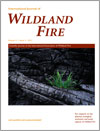International Journal of Wildland Fire
Volume 21
Number 3 2012
Wildfire managers operate in a highly challenging decision environment characterised by complexity, multiple conflicting objectives and uncertainty. Operations research (OR) is a discipline that uses analytical techniques to aid decision-making in complex systems. This paper discusses a range of OR methods available to assist wildfire managers, with illustrative examples drawn from the wildfire and disaster OR literature.
Conservation efforts on private land contribute to minimising biodiversity loss. These efforts also include maintaining ecological processes, such as fire. Fire management is complex and private landholders must balance conservation efforts with risks to life and property. Our research shows that fire is poorly understood potentially compromising management effectiveness.
This research focussed on impediments to prescribed fire in northern California, USA, using a survey of fire managers from a range of management entities. Impediments vary by geographic region and entity, pointing to the importance of context in prescribed fire management.
Containment times of fires with aerial suppression were compared with estimated containment times for the same fires without aerial suppression. Fire managers believe that aircraft reduce time to containment when firefighting conditions are challenging owing to fuel hazard rating, weather conditions, ground response times and area burning at initial attack.
Spatial and temporal analysis of wildfire in Canada was completed to create baseline expectations of ignitions at 1-km spatial units. This baseline is used to delineate unique ignition regimes and explore anthropogenic influence on ignition expectation, variation and trend.
This paper assesses post-fire changes in land surface temperature (LST) and surface albedo (α) using remotely sensed time series Lag, i.e. time since fire, and seasonal timing affected the magnitude of post-fire changes. Moreover, the seasonality constrains the suitability of the LST and α layers as indicators of fire severity and burn severity.
This study evaluates the potential of MODIS-derived spectral indices to predict live fuel moisture content of three different fire-prone vegetation types (i.e. shrubland, heathland and sclerophyll forest) in the Sydney Basin Bioregion (Australia).
Flame temperature profiles and flame-front residence times were measured from a series of experimental fires in dry eucalypt forest of different fuel age and structure. A method to estimate flame temperature at any height within the flame was developed. Average flame-front residence time for eucalypt forest fuels was 37 s.
This paper considers an atypical form of fire propagation, characterised by rapid lateral spread, and associated spot-fire development, across steep, lee-facing slopes. The role of wind, terrain and fire interaction in driving the phenomenon is investigated using weather, elevation and multispectral fire data and a likely explanation for the atypical spread is hypothesised.
Fire history mapping for 1990–2009 is used to quantify the mitigation of late dry-season wildfire (LDS) through prescribed burning in Western Arnhem Land. Prescribed burning can substantially reduce LDS area, by direct one-to-one replacement. A management program operating since 2005 has successfully reduced LDS using prescribed fire.
South-western ponderosa pine stands attacked by bark beetles had higher tree densities compared to stands not attacked. Five years post-outbreak, after adjusting for differences in pre-outbreak tree density, attacked stands had lower tree densities and lower canopy fuel loadings, but higher surface fuel loadings than stands that were not attacked.




